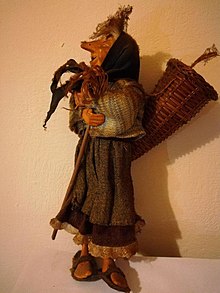
Back بيفانا Arabic Befana BCL Бефана Bulgarian বেফানা Bengali/Bangla Befana Breton Befana Catalan La Befana Czech Befana German Μπεφάνα Greek Befàna EML

In Italian folklore and folk customs, the Befana (Italian: [beˈfaːna]) is a witch-like old woman who delivers gifts to children throughout Italy on Epiphany Eve (the night of January 5) in a similar way to Santa Claus or the Three Magi.[1] The Befana is a widespread tradition among all Italians and thus has many names. She is a part of both popular national culture and traditional folk culture and is akin to other figures who roam about sometime during the Twelve Days and reward the good, punish the bad, and receive offerings. The Befana is a mysterious, contradictory figure of unclear origins. This character is enhanced by the fact that she is overall neglected by scholars but is the subject of much speculation by the ones who do mention her. Pre-Christian, Christian, and syncretism of the two have all been postulated as explanations of her origins. In some parts of Italy, especially the central regions, mumming takes place on Epiphany eve. Dolls are made of her and effigies are burnt and bonfires are often lit. She brings gifts to good children in some parts of Italy, typically sweets, candies or toys but coal, cinders and garlic to bad children. She is usually portrayed as a hag riding a broomstick through the air wearing a black shawl and is covered in soot because she enters the children's houses through the chimney. She is often smiling and carries a bag or hamper filled with candy, gifts, or both.[citation needed] She is not only loved but also feared and mocked, particularly by children.
- ^ Illes, Judika. Encyclopedia of Spirits: The Ultimate Guide to the Magic of Fairies, Genies, Demons, Ghosts, Gods & Goddesses (2009) p. 269. ISBN 978-0-06-135024-5
© MMXXIII Rich X Search. We shall prevail. All rights reserved. Rich X Search